The Directorate General of Foreign Trade (DGFT), under the Government of India’s Ministry of Commerce and Industry, introduces a transformative shift in export documentation with the revamped Electronic Bank Realisation Certificate (eBRC) system. This article delves into the details of this significant upgrade, outlining the changes, benefits, and implications for exporters and banks.
DIRECTORATE GENERAL OF FOREIGN TRADE
GOVERNMENT OF INDIA
MINISTRY OF COMMERCE AND INDUSTRY
Revamped eBRC System
Electronic Bank Realisation Certificate(eBRC)
About eBRC
- “eBRC” stands for “electronic Bank Realisation Certificate”.
- eBRC serves as proof of realization against exports done
- Issued on DGFT platform by concerned banks at the request of exporter
Uses of eBRC:
To avail incentives under Foreign Trade Policy of DGFT
- Advance Authorisation scheme
- Export Promotion Capital Goods Scheme (EPCG)
- MEIS / SEIS / TMA (legacy schemes)
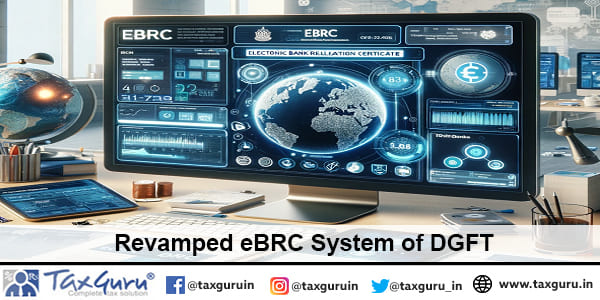
GST complainces (Rule 89(2) of the CGST Rules)
- Refund of unutilized input tax credit (ITC) on account of exports without payment of tax.
- Refund of tax paid on export of services with payment of tax
- Refund of unutilized ITC on account of supplies made to SEZ Unit/SEZ Developer without payment of tax
- Refund of tax paid on supplies made to SEZ Unit/SEZ Developer with payment of tax
- Refund to supplier of tax paid on deemed export supplies
- Refund to recipient of tax paid on deemed export supplies
Current process to obtain eBRC – Merchandise exports
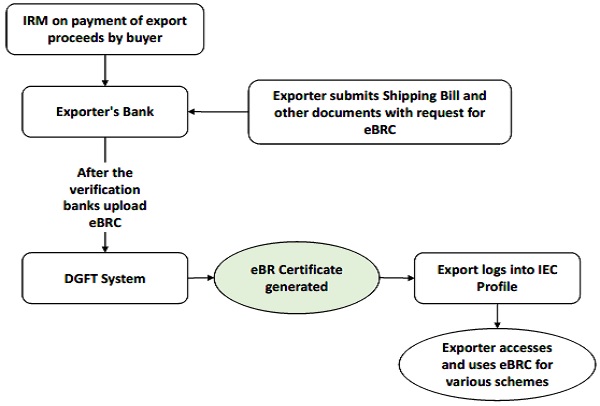
- Exporter submit the documents to the banks with a request for eBRC generation.
- After verification banks upload the eBRC to the DGFT system.
- Thereafter, Exporter can download the eBRC from the DGFT Website and use the same.
Current process to obtain eBRC – Services exports
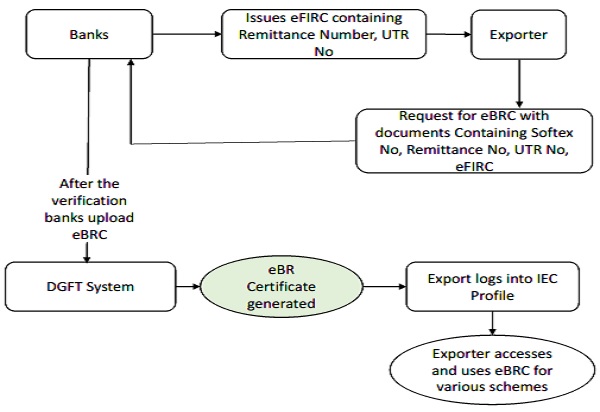
- As per request of Exporter bank issue eFIRC to the Exporter.
- After collecting Softex certificate, eFIRC, shipping bill No. and other relevant documents, Exporter submit the documents to the banks for eBRC.
- After verification banks upload the eBRC to the DGFT system.
- Thereafter, Exporter can download the eBRC from the DGFT Website and utilise it.
Issues in current eBRC process flow
Issues for banks
- Substantial burden at banks with increasing exports
- Banks have to update eBRC/ EDPMS for each transaction
- Banks need to verify multiple documents for offsetting the IRMs
- Cumbersome process if cancellation and change in eBRC is required
Issues for exporters
- Substantial transaction since request for each eBRC needs to be submitted to banks
- Multitude of paper documents to be submitted
- Copies of all Shipping Bills and invoices (select banks) to be submitted for merchandise exports
- Each SOFTEX reconciliation requires 24 paper sheets for services export
- Each Courier export transaction requires at least 3 documents.
- More documentary submission for clarifications and need for follow up to ensure final issuance
- Result is delay in getting export benefits, GST refunds filings etc
Issues in current eBRC process flow – Services exports
eBRC system is not being used meaningfully to generate granular Service export data
- eBRC is being used for claiming GST Refunds for Software and other service exports.
- However, no Service classification is being captured under eBRC system.
- The refund applicant may choose to generate a FIRA instead of an eBRC. All such data is also not being captured.
- Various legacy and current classifications are being followed by various agencies, owning to which standardisation and analysis is not feasible without detailed concordance of the data sets
| System | Nomenclature |
| SOFTEX | Based on RBI purpose codes |
| Foreign Inward Remittance Advice (FIRA) | RBI purpose codes |
| FETERS | Based on FETERS purpose codes |
| GSTN | Based on updated Servicing Accounting Code (SAC) Codes |
| eBRC | SAC codes are an optional field for service exports |
Major Changes in the revamped eBRC system
- Based on trust in Indian exporters
- eBRC shall henceforth be generated by exporters themselves via self certification
- Cost free process on DGFT portal
- Need for application and request to banks for generation done away with
- Paperless process without the need for any paper submission to any authority at the time of generation
- A Risk Management based post audit mechanism for banks and other stakeholders to verify bonafides
- Each bank will decide own cut off date to move to self certification based eBRC generation
- IRMs received after cutoff date will be available to exporter for self certification based eBRC generation
- Bank cutoff date available on DGFT website
- Self certified eBRC generation will be based on system based checks as per Business rules
- Business rules available on DGFT website
- Trade Notice 33/2023-24 dt. 10th November 2023 maybe referred for more details 7
Revamped process flow for eBRC generation
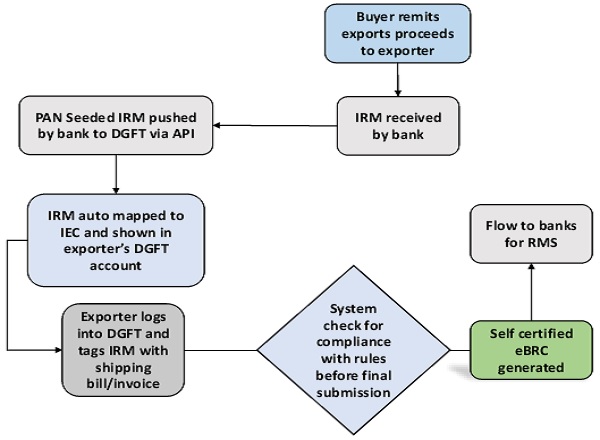
- DGFT already captures Exporter’s Bank account details and PAN under IEC issued
- All Inward Remittance Message(IRM) mapped with PAN to be pushed by the banks to DGFT using a API integration
- The given inward remittance details shall automatically appear in account of respective IEC holder
- Exporter may tag the inward remittance with the shipping bill/invoice to generate eBRCs directly.
- eBRCs so generated will flow to banks for post audit risk management as per banks’ own process
- eBRC also planned to be digitally shared with other agencies in future
Major Benefits of the revamped eBRC system
- Reduction in compliance costs for exporters
- Cost free generation – Cost burden reported especially by MSME exporters alleviated
- Paperless generation
- Opens new avenues for small exporters
- Especially useful for e-commerce exports with low cost, high volume of transactions to claim benefits and refunds
- Workload reduction for banks
- Scaling of system made possible in light of GoI’s target of 1 Trillion exports each for Merchandise and Services by 2030
- Banks will focus on targeted risks only instead of checking all transaction documents
- Aid targeted policy making
- Near real-time granular data on service exports at SAC code level will now be available
- This data would allow for further automation at DGFT and other agencies and frame more targeted schemes and strategies for service exports.
Rules and guidelines published on DGFT website
DGFT website (www.dgft.gov.in) –> Services –> eBRC
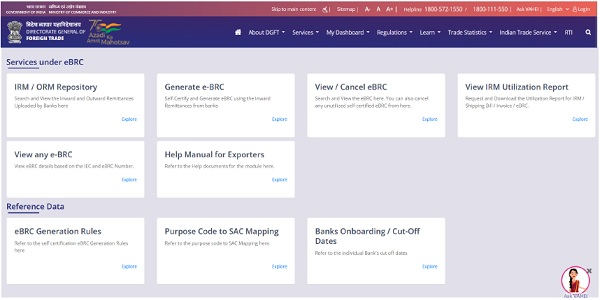
Thank you
DGFT Support channels
- Toll-Free Helpdesk Support Number 1800 572 1550
- Raise a Helpdesk ticket by navigating to DGFT website — > Services — > DGFT Helpdesk Service Feedback on eBRC rules and PC-SAC mapping / any other feedback
- Write to ebrc-dgft@gov.in




